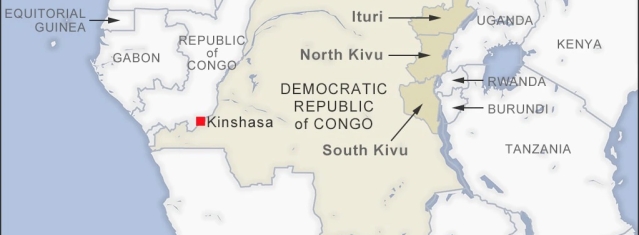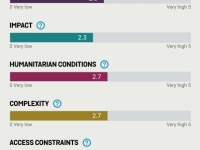News
DR Congo Complex Crisis
ACAPS Report

(Source: Photo by VOA via ACAPS)
ARAC International StratCom -
Crisis Severity 4.2
The severity score from 1 to 5 is based on 31 indicators aggregated into 3 pillars (impact, conditions, and complexity)
Impact 4.5
This measures the impact of the crisis itself, in terms of the scope of its geographical, and human effects.
Humanitarian Conditions 4.0
This measures the conditions and status of the people affected, including info about the distribution of severity.
Complexity 4.4
This measures the complexity of the crisis, in terms of factors that affect its mitigation or resolution.
Access Constraints 4.0
This measures the level of humanitarian access constraints.
For more on ACAPS methodology copy and paste the following link into your browser:
https://www.acaps.org/methodology
The severity score from 1 to 5 is based on 31 indicators aggregated into 3 pillars (impact, conditions, and complexity)
Impact 4.5
This measures the impact of the crisis itself, in terms of the scope of its geographical, and human effects.
Humanitarian Conditions 4.0
This measures the conditions and status of the people affected, including info about the distribution of severity.
Complexity 4.4
This measures the complexity of the crisis, in terms of factors that affect its mitigation or resolution.
Access Constraints 4.0
This measures the level of humanitarian access constraints.
For more on ACAPS methodology copy and paste the following link into your browser:
https://www.acaps.org/methodology
OVERVIEW
16/11/2021A complex emergency has persisted in DRC for more than 20 years. Population displacement is frequent and repeated, and mostly driven by armed clashes and intercommunal violence between foreign, self-defence, and other armed groups. More than five million people are internally displaced. The situation in the eastern provinces remains particularly volatile: humanitarian needs are high, as displaced and local populations are faced with violence, food insecurity, floods, disease outbreaks, and the secondary effects of COVID-19 restrictions. Over 998,000 refugees from DRC live in African host countries as at 31 October. DRC hosted about 515,000 refugees (mainly from Rwanda, Central African Republic, Congo, and Angola) as at 30 September. Since mid-December 2020, 92,000 refugees fleeing violence related to the 27 December elections in CAR have arrived in Bas-Uele, Nord-Ubangi, and Sud-Ubangi provinces. Most of the arrivals are located in villages close to the river border, where access is a challenge and where host communities were already struggling to meet their own needs.
Over 7,900 protection incidents were reported across DRC in 2020, a 21% increase from 2019
UPDATE FROM THE FEBRUARY 2022 RISK ANALYSIS
26/10/2022MEDIUM RISK LEVEL
The resurgence of the 23 March Movement (M23) and intensification of conflict lead to displacement and further deterioration of the humanitarian situation in Nord-Kivu
The risk that we identified in March has materialised. The humanitarian situation in the territories of Rutshuru and Nyiragongo (Nord-Kivu) has deteriorated since March 2022 because of the resurgence of the M23. Continued clashes between the armed group and the Congolese army have displaced at least 186,000 people within Nord-Kivu province, while an estimated 58,000 people have taken refuge in neighbouring Uganda since January 2022. More than 210,000 people need humanitarian assistance, mainly in Rutshuru and Nyiragongo territories, as a result of this crisis.
On 13 June, the M23 took control of the city of Bunagana, hampering economic activities. Abuses against civilians were reported?. The Government made the withdrawal of the M23 from the city of Bunagana a prerequisite for any negotiations with the armed group. The violence also had political implications given Rwanda’s alleged support of the M23.
This support led to violent protests against Rwanda in several provinces of the Republic of Congo. Demonstrators targeted people suspected of being of Rwandan origin and looted or destroyed their property. The tensions eased after a meeting between the presidents of the two countries.
In July, violent demonstrations accusing MONUSCO of ineffectiveness in the fight against armed groups took place in Goma, Butembo (Nord-Kivu), and Uvira (South Kivu), killing civilians and soldiers.
In July, violent demonstrations accusing MONUSCO of ineffectiveness in the fight against armed groups took place in Goma, Butembo (Nord-Kivu), and Uvira (South Kivu), killing civilians and soldiers.
LATEST DEVELOPMENTS
26/10/2022At least 23,000 people have been displaced following renewed clashes between the Congolese army and the March 23 Movement (M23) since 20 October in several localities of Rutshuru territory (North Kivu). Some of the newly displaced people fled to neighbouring localities while around 2,500 others have found refuge in Uganda. In Ntamugenga locality, civilians and injured people found themselves trapped by the intense clashes around them and have been unable to flee as the fighting continues. Some localities such as Kabaya, Biruma, Kalengera or Rumangabo where IDPs have fled, are near areas of M23 activity, making additional displacement likely in the coming weeks. The violence is likely to further increase humanitarian access constraints and delay assistance to thousands of people. Nearly 400,000 displaced people are reported in Rutshuru territory where the most urgent needs include food, WASH, education and healthcare.
HUMANITARIAN ACCESS
07/07/2022VERY HIGH CONSTRAINTS
DRC faced Very High humanitarian access constraints in the past six months, scoring 4/5 in ACAPS Humanitarian Access Index. The humanitarian access situation remained stable.
For more information you can consult our latest Global Humanitarian Access Overview – July 2022.
Copy and paste the following link into your web browser to download the humanitarian access overview for July 2022
https://www.acaps.org/sites/acaps/files/products/files/acaps_humanitarian_access_overview_july_2022.pdf
https://www.acaps.org/sites/acaps/files/products/files/acaps_humanitarian_access_overview_july_2022.pdf
KEY PRIORITIES
13/01/2021Health: Displacement often leads to the loss or deterioration of access to health services. Poor WASH infrastructure contributes to the spread and risk of outbreaks of communicable diseases such as measles, cholera, malaria, Ebola, and COVID-19.
Protection: Protection concerns remain high, particularly among IDPs, returnees, refugees, and host communities. Those who commit protection violations often go unpunished and victims have limited access to support structures. Reported GBV incidents increased by 86% between January–September 2020 compared to the same period in 2019. This increase can likely be attributed to continued violence and displacement and COVID-19-related restrictions, as well as increased public awareness and operational capacity which have allowed for increased reporting of GBV cases.
Food security: Conflict and displacement are the main drivers of food insecurity. Seasonal floods, along with crop and animal diseases, further affect livelihoods. Poor road infrastructure limits access to markets.
This work is licensed under a Creative Commons Attribution Non Commercial No Derivatives 4.0 International license
Originally published by ACAPS.org and republished by ARAC.
____________________________________________________________
Office of Strategic Communications & Analysis
ARAC International, Global Security Analyst | Human Rights Consultant
Certified by the U.S. Institute for Diplomacy and Human Rights
Institute for Economics and Peace Ambassador
https:/iep.arac-international.org
more information: https://www.arac-international.org/2022/10/acaps-dr-congo-crisis-update-10262022.html
Liability for this article lies with the author, who also holds the copyright. Editorial content from USPA may be quoted on other websites as long as the quote comprises no more than 5% of the entire text, is marked as such and the source is named (via hyperlink).






